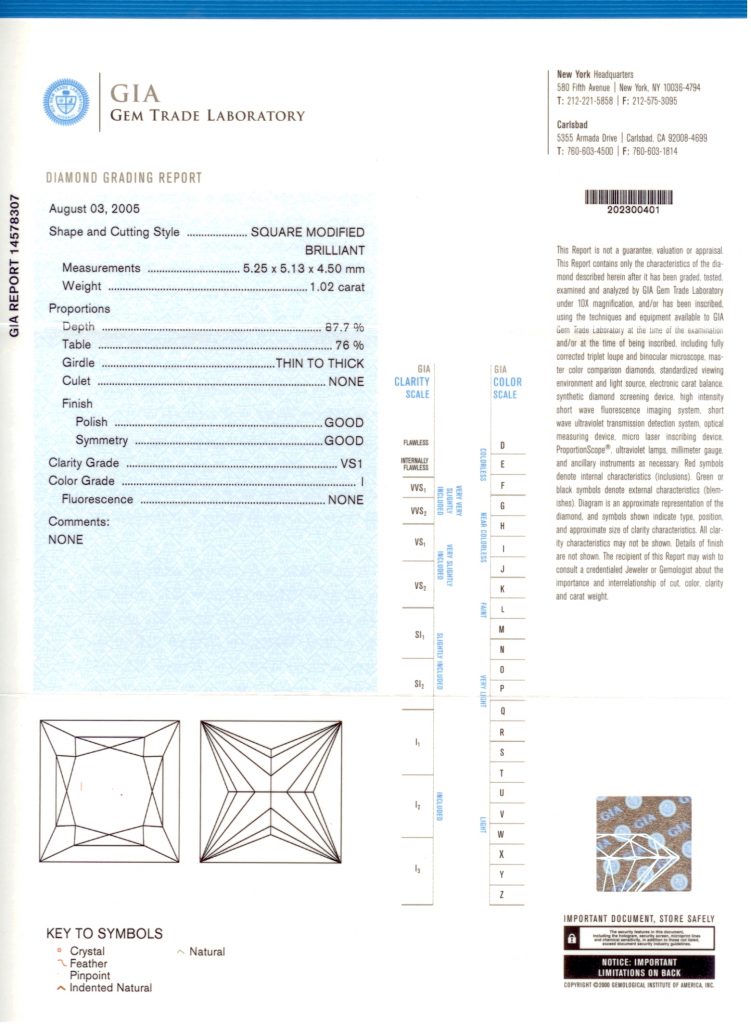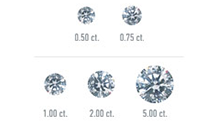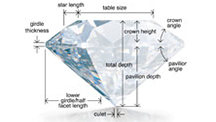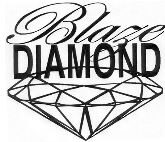Color – Clarity – Carat Weight – Cut

A diamond’s value is determined by the 4 C’s, which are the primary grading criteria for all diamonds. Color, Cut, Clarity and Carat Weight are important, as they affect the brilliance and visual appearance of your diamond.
Color:
- D, E, F –Colorless– The most rare, no yellow.
- G, H, I, J –Near Colorless– No yellow tint visible
- K, L, M, N, O, P, Q, R, S –Very Light Yellow– The Yellow starts to become more visible
- T, U, V, W, X, Y, Z – Fancy Light Yellow such as brilliant “Canary” Diamonds
As described above; D, E and F are considered colorless; G,H,I and J are considered near colorless by GIA standards. The scale goes all the way to “Z.”
Only the trained eye can tell the difference between diamonds that are ‘next to each other’ as far as color, like a “D” and “E” or even an “I” and “J”. Even then, a person must have the correct lighting and grading equipment and the diamond must be flipped upside down, which is how they are most accurately graded.
If two color grades separate a pair of diamonds, such as an “D” compared to an “F”, you can just barely start to see the difference. The color difference is so minor and it is only possible to see this slight difference, if the diamonds are physically next to each other and under really good lighting.
“D” is the best –the King of Colorless– Nothing can compare to it. It is the best color the laws of physics allow. Anyone can see the difference between a “D” and an “H, I or J” if they are next to each other in any average lighting. The difference is like night and day. An “H” color graded diamond is good, and it isn’t yellow, but it also isn’t a “D”.
When choosing a stone, we usually recommend a diamond in the Colorless or near colorless range. This will ensure that the diamond will have the best appearance possible, tailored to your budget.
Color grade increases are relatively inexpensive, as compared to moving up a grade of Clarity. Put your money on the best Color option possible, it is a difference you both can see.
Clarity
- FL – Flawless – Absence of external flaw, blemish or internal inclusions when examined by a trained grader under 10X magnification.
- IF – Internally Flawless – Absence of inclusions when examined by a trained grader under 10X magnification.
- VVS1 & VVS2 – Very Very Small Inclusions – Only microscopic inclusions that are difficult for highly trained grader to locate with 10X loupe. VVS1 is the higher end of the range.
- VS1 & VS2 – Very Small Inclusions – Minute inclusions from difficult (VS1) to more visible (VS2) for an expert grader to see with 10X.
- SI1 & SI2 – Small Inclusions – With 10X loupe, noticeable inclusions which are easier to see under magnification. Some SI2 can have a pinpoint barely visible with unaided eye.
- I1 & I2 & I3 – Inclusions Visible- Without loupe, the inclusions can be seen under close inspection. The color of the inclusion and its location will determine how easily it can bee seen.
As long as you choose an “SI” diamond or better (to GIA standards, not EGL standards) it should not be possible to readily see any inclusions with the naked eye. An SI diamond will save you money as compared to a VS or VVS. A jeweler’s loupe is required to see any flaws in an SI1 diamond . A “VS” diamond has an inclusion so small that it is difficult to find any inclusions even with a loupe, which makes it more rare and more expensive than an “SI” diamond.A “VVS” diamond is even higher priced as it is nearly impossible to see the inclusion, even with a loupe.
Carat Weight
Compared to Color and Clarity, the Carat weight is one of the few properties of a diamond that the cutter can control. Generally, as diamond weight increases by 100% (double the weight), the cost of the diamond can increase by 200%. A .50 ct diamond that will cost $1000, may cost $3000-$4000 if it is a full carat.
Cut / Proportion
The cut of a diamond is the size and angle of facets, as they are oriented to each other. A diamond which is cut to correct proportions will reflect light back through the Table and Crown, where an incorrectly proportioned diamond will lose its brilliance as the light escapes through the bottom portion or “Pavilion.”
If you are interested in a 4C’s online tutorial check out the GIA’s website.
The 5th “C” – Certification
The basic anatomy of a certification will have most or all of the following:
- Certification Date
- Report #
- Laser Engraved Inscription (if different)
- Diamond Shape
- Measurements to 100th of a millimeter (i.e. 7.56mm x 4.34mm)
- Carat Weight
- Color
- Clarity
- Cut Grade
- Finish
- Polish
- Symmetry
- Fluorescence
- Comments
- Reference Diagrams
- Complete Color and Clarity Scale for comparison
- Complete Cut Grade Scale for comparison
- Proportion Diagram
- Key to symbols
- Security Features

More Information




More Diamond Lingo
Terms Explained
- Brilliant (Round)
This is the most popular style of all diamond shapes. It consists of 57 facets, 58 if the culet is also faceted.
- Fancy
Any other geometry such as Princess, Pear, Marquise, Emerald, Oval and Heart-shaped.
- Facets
The flat, polished surfaces of a diamond.
- Table
The top facet.
- Girdle
The outer diameter which is the outermost ‘edge’ of the diamond. The girdle plane is the largest diameter of the diamond.
- Crown
The top portion of the diamond, above the girdle.
- Pavilion
The bottom portion of the diamond, below the girdle.
- Culet
The pointed bottom of the pavilion, sometimes polished with a tiny facet, sometimes pointed with no facet. It is linear on some shapes such as Emerald cut.
Fluorescence
It is the natural, blue glow of some diamonds under Ultra Violet light. It is a minor point. It is a way to differentiate between nearly identical diamonds and to make the ‘fingerprint’ of the diamond more specific within the certification. It isn’t good or bad, it just “is”. With a diamond that is I or J, some argue that you want strong Fluorescence, because the Fluorescence can mask the ‘tint’ and make it look slightly whiter. With a Colorless diamond, it really doesn’t matter. Since Fluorescence occurs under 344 nanometer wavelength light, it really is a minor point and not noticeable under normal conditions, unless you put it under a black light or ultraviolet lighting.
Judging a diamond as “good” or “bad” strictly from the stand point of Fluorescence, is like saying, “I could have bought that Ferrari Testarossa for $5,000… but I didn’t like the shape of the gas pedal.” If you put a pair of 1ct, colorless, round earrings together with one diamond having “Strong” and the other having “None/Nil”. You couldn’t tell one from the other. Try it yourself! Go downtown and have 2 GIA diamonds of the same color/shape, put side by side with differing fluorescence (Strong and None) and see if you can tell a difference.
Polish
The extent to which the surface of the stone is free of scratch or defect under 100x magnification.
Proportion
The size and angle of facets, as they are oriented to each other. A diamond cut to correct proportions will reflect light back through the Table and Crown, where an incorrectly proportioned diamond will lose its brilliance as the light escapes through the bottom, Pavilion
Color
Color describes the presence or absence of ‘yellow’ in a diamond.
Clarity
Clarity describes the absence of imperfections or “inclusions” and the relative purity of a diamond.
- FL – Flawless: Absence of external flaw, blemish or internal inclusions when examined by a trained grader under 10X magnification.
- IF – Internally Flawless: Absence of inclusions when examined by a trained grader under 10X magnification.
- VVS1 & VVS2 – Very Very Small Inclusions: Only microscopic inclusions that are difficult for highly trained grader to locate with 10X loupe. VVS1 is the higher end of the range.
- VS1 & VS2 – Very Small Inclusions: Minute inclusions from difficult (VS1) to more visible (VS2) for an expert grader to see with 10X.
- SI1 & SI2 – Small Inclusions: With 10X loupe, noticeable inclusions which are easier to see under magnification. Some SI2 can have pinpoint barely visible with unaided eye.
- I1 & I2 & I3 – Inclusions Visible: Without loupe, the inclusions can be seen under close inspection. The color of the inclusion and its location will determine how easily it can bee seen.
Carat Weight
A diamond’s weight is measured in Carats. Compared to Color and Clarity, the Carat weight is one of the few properties of a diamond that the cutter can control. Generally, as diamond weight increases by 100% (double the weight), the cost of the diamond can increase by 200%. A .50 ct diamond that will cost $1000, may cost $3000-$4000 if it is a full carat.
Carats to Millimeters Conversion Chart available just email us.
Cut / Proportion
Cut is controlled by the skill of the cutter. Correct cut has high importance because it affects the brilliance and fire of the diamond. The cut of a diamond is the size and angle of facets in relation to how they are oriented to each other. A diamond which is cut to correct proportions will reflect light back through the Table and Crown (top part of the diamond), where an incorrectly proportioned diamond will lose its brilliance as the light escapes through the Pavilion (bottom of the diamond).
Want to learn more?
- Move on to the Carat Weight Page
